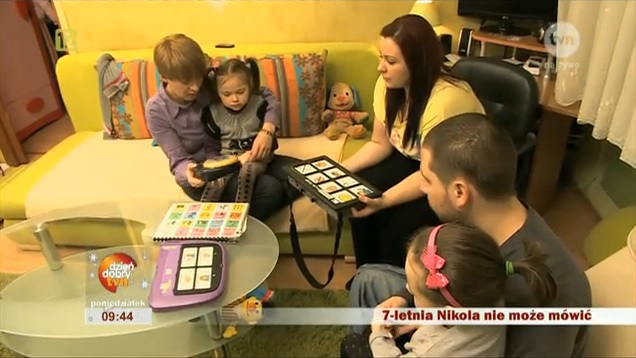Rett Syndrome


Last modified: 04-12-2023
Rett syndrome is a rare neurological disorder with a genetic background. Due to its symptoms, it is often confused with autism or cerebral palsy. Children with Rett Syndrome also often get an unfounded diagnosis of mental disabilities.
Rett syndrome affects between 1: 10,000 and 1: 23,000 girls. It was first described by the Austrian doctor Andreas Rett in 1966, but due to the publication in German, it did not reach a wider audience. Knowledge about Rett Syndrome did not spread until 1983, after an article on the subject was published in the Annals of Neurology. However still many doctors and psychologists do not know about this syndrome.
How to recognize Rett syndrome
Rett syndrome has 4 phases.
Phase I – approx. 6-18 months
Children with Rett Syndrome are born healthy and their development usually does not arouse suspicions for the first several months. As babies, they are often calm, cry little and sleep a lot, which parents usually consider to be their advantage. The first noticeable symptoms usually appear between 6 and 18 months. Children then lose interest in toys, show less eye contact and often have muscle hypotonia (weakness) and slower growth of head.
Phase II – approx. 1-4 years
The second phase is a period of regression that sometimes begins before the age of one, and sometimes later, even at around 4 years of age. Children then lose the already acquired skills, mainly the ability to use hands and speech. Those who have already learned to walk often lose this ability as well.
Stereotypical hand movements are characteristic, for example, movements like washing hands, clapping, and putting them in the mouth. There are also sleep disturbances and nocturnal bouts of unjustified laughing or crying. Many children with Rett Syndrome begin to develop breathing difficulties at this stage – air holding, hyperventilation, or swallowing air. Bruxism (teeth grinding) and seizures are also common. A characteristic feature of the regression phase is also the deterioration of social contacts, which is often the reason for the misdiagnosis of autism. Children with Rett syndrome also have an impaired pain response (either too strong or too weak) which is also common in autism.
The regression phase sometimes takes weeks and sometimes months. Loss of skills may be sudden, slow, or staged.
Phase III – preschool and school age
In the third phase, the child’s condition begins to stabilize. Social and emotional contact improves, bouts of crying disappear and a strong desire to explore the world becomes visible. However, the physical condition does not improve. There are still movement problems and epilepsy. Children have great difficulty or even total inability to move (ataxia or apraxia). During this period, problems with the skeletal system also appear: scoliosis (curvature of the spine), sometimes requiring surgical treatment, and deformities of the feet and ankles.
Phase IV – from adolescence
In the fourth phase of Rett Syndrome, mobility decreases. Most children who have been able to walk up to this point lose this ability. On the other hand, stereotypical hand movements and epileptic seizures often disappear or lessen. There is also further improvement in eye contact and emotional contact. Not all people with Rett Syndrome go through this phase, and many stop in phase III.
Atypical Rett Syndrome
About 20% of children with Rett syndrome have an atypical course of the disease. Some of them experience a developmental delay shortly after birth and do not go through a normal phase of development during infancy. The regression phase is not present either, as such children have not acquired the skills that are usually lost during this phase. Such children often receive a diagnosis of cerebral palsy.
In other children with Atypical Rett Syndrome, the first signs of the disorder appear later than usual, sometimes by the age of three to four. Such children can often walk and even run. They are also often misdiagnosed as autism.
Some children, on the other hand, have mild Rett Syndrome, in which the ability to speak and use hands is preserved. The atypical varieties of Rett syndrome also include having this disorder in boys.
What causes Rett Syndrome
Rett syndrome is a genetic, dominant, sex-linked disease. The disease is usually caused by mutations in the MECP2 gene, although there are people who have a mutation in this gene and do not have symptoms of Rett syndrome and people with Rett syndrome who have not been shown to have a mutation in this gene.
The MECP2 gene is located on the X chromosome and encodes the MeCP2 protein, which is involved in switching off other genes when needed. If the MECP2 gene is malfunctioning, other genes are turned on at inappropriate times. The proteins and enzymes encoded by these genes may therefore be present in too little or too much, which disrupts the development of the nervous system. In the first months of life, these relationships do not play a large role, therefore the child in this period usually does not show obvious symptoms of the disease.
People with Rett Syndrome are almost always girls. If the mutation causing this syndrome happens to a boy, it usually causes more serious disturbances and the baby dies before or shortly after birth.
Rett syndrome is almost always caused by a spontaneous mutation. This mutation is very rarely inherited, although it is interesting that the genetic background of this syndrome was discovered thanks to a family in which several persons had this mutation. It happened in 1999 and the story of this family is presented in the film Silent Angels.
Rett Syndrome and brain
The brains of people with Rett syndrome show many abnormalities. Belong to them:
- decreased blood flow in the frontal lobe (a region involved in the regulation of emotions),
- reduction of pyramidal cell dendrites in the frontal lobe,
- reduced size of the caudate nucleus (responsible for movement control),
- reduced number of dendrites in certain areas of the temporal lobe (region involved in learning, memory, emotions and behavior),
- reduction of the size of the cerebellum (responsible for the sense of balance and motor memory),
- reduced size of the hippocampus and increased density of nerve cells in this structure (responsible for information processing and memory),
- reduced amount of neuromelanin in some black matter cells (involved in the regulation of movement),
- abnormal secretion of neurotransmitters: dopamine (plays an important role in the areas responsible for movement and critical thinking), acetylcholine (participates in memory and movement control), glutamate (important in neuroplasticity processes), substance P (plays a role in pain recognition) and serotonin ( essential for early brain development).
There are also signs of immaturity of the brain stem, which is involved in such processes as sleep control, saliva production, control of breathing, heartbeat, swallowing, intestinal peristalsis, blood circulation in the hands and feet, and pain sensitivity. All these processes are often disturbed in people with Rett Syndrome.
Rett Syndrome and the level of intelligence
Children with Rett Syndrome are often diagnosed with intellectual disabilities, but such diagnoses are unjustified. All intelligence tests require the ability to speak or use your hands. For obvious reasons, people with Rett Syndrome, who cannot speak or use their hands, perform very poorly in such tests. However, a mistake is made by a psychologist who makes a diagnosis of mental retardation on this basis. The correct diagnosis in such a situation is “level of intelligence unable to measure”.
In recent years, studies have been conducted in which the eyesight of children with Rett Syndrome was monitored using eye-tracking technology. One study showed that children with Rett Syndrome were able to distinguish new pictures from pictures previously shown, although they were weaker at it than the control group. It has also been shown that they prefer to look at faces rather than objects, and eyes are particularly eye-catching for them, which is different from autistic people who avoid eye contact and are more interested in objects.
Tests that can measure intelligence by eye tracking have not yet been developed. However, parents and doctors who come into contact with people with Rett Syndrome often believe that they understand much more than they are able to convey. Children with Rett syndrome, despite the lack of speech and the ability to make hand movements, show a strong willingness to communicate. They try to communicate by sight, and can often point out a picture with the appropriate message with their hands or, if it is too difficult for them, with their nose. The girl who communicated with her relatives in this way was one of the participants of the report on Polish program Dzień Dobry TVN.
References
- Dorota Kosno, Zespół Retta – Zaburzenie Neurorozwojowe o Podłożu Genetycznym (rettsyndrome.pl)
- Kathy Hunter, The Rett Syndrome Handbook. Second Edition. (you can download at rettsyndrome.pl)
- Rose, S. i in. (2013). Rett syndrome: an eye-tracking study of attention and recognition memory. Developmental Medicine & Child Neurology, 55(4), 364-371 (text at wiley.com)
- Cognitive abilities of rett syndrome patients have been underestimated for decades, researchers find (sciencedaily.com)
Author: Maja Kochanowska







Add comment